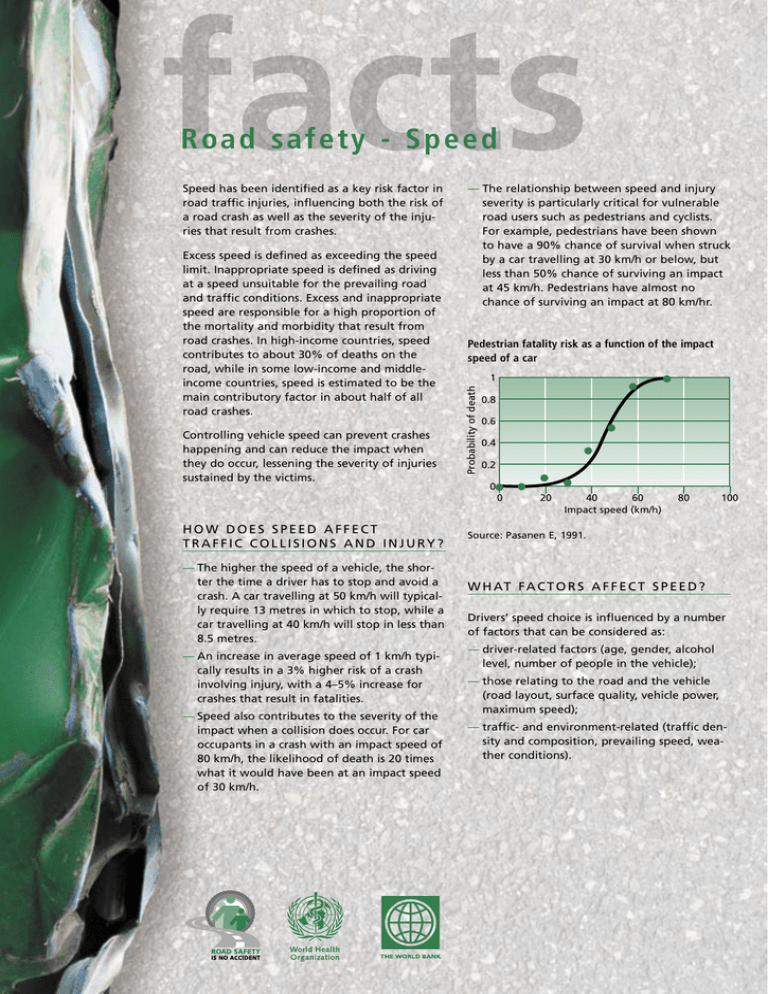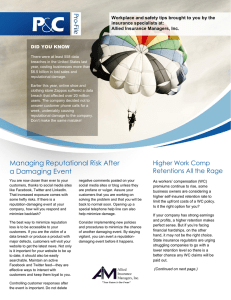
R o a d s a f ety - Speed
Excess speed is defined as exceeding the speed
limit. Inappropriate speed is defined as driving
at a speed unsuitable for the prevailing road
and traffic conditions. Excess and inappropriate
speed are responsible for a high proportion of
the mortality and morbidity that result from
road crashes. In high-income countries, speed
contributes to about 30% of deaths on the
road, while in some low-income and middleincome countries, speed is estimated to be the
main contributory factor in about half of all
road crashes.
Controlling vehicle speed can prevent crashes
happening and can reduce the impact when
they do occur, lessening the severity of injuries
sustained by the victims.
— The relationship between speed and injury
severity is particularly critical for vulnerable
road users such as pedestrians and cyclists.
For example, pedestrians have been shown
to have a 90% chance of survival when struck
by a car travelling at 30 km/h or below, but
less than 50% chance of surviving an impact
at 45 km/h. Pedestrians have almost no
chance of surviving an impact at 80 km/hr.
Pedestrian fatality risk as a function of the impact
speed of a car
1
Probability of death
Speed has been identified as a key risk factor in
road traffic injuries, influencing both the risk of
a road crash as well as the severity of the injuries that result from crashes.
0.8
0.6
0.4
0.2
0
0
HOW DOES SPEED AFFECT
TRAFFIC COLLISIONS AND INJURY?
— The higher the speed of a vehicle, the shorter the time a driver has to stop and avoid a
crash. A car travelling at 50 km/h will typically require 13 metres in which to stop, while a
car travelling at 40 km/h will stop in less than
8.5 metres.
— An increase in average speed of 1 km/h typically results in a 3% higher risk of a crash
involving injury, with a 4–5% increase for
crashes that result in fatalities.
— Speed also contributes to the severity of the
impact when a collision does occur. For car
occupants in a crash with an impact speed of
80 km/h, the likelihood of death is 20 times
BANCO MUNDIAL
what it would have been at an impact
speed
of 30 km/h.
BANQUE MONDIALE
20
40
60
Impact speed (km/h)
80
100
Source: Pasanen E, 1991.
W H AT F A C T O R S A F F E C T S P E E D ?
Drivers’ speed choice is influenced by a number
of factors that can be considered as:
— driver-related factors (age, gender, alcohol
level, number of people in the vehicle);
— those relating to the road and the vehicle
(road layout, surface quality, vehicle power,
maximum speed);
— traffic- and environment-related (traffic density and composition, prevailing speed, weather conditions).
W H AT C A N B E D O N E T O M A N A G E
THE ADVERSE EFFECTS OF SPEED?
measures can be particularly useful where
enforcement of speed control laws may be
ineffective.
A number of interventions have been identified
to be effective in the management and control
of vehicle speed:
— The transition from high-speed to lowspeed roads can create areas of high risk for
crashes – for example, where vehicles exit
motorways. Design features can be used to
mark transition zones on busy roads approaching towns and villages that can influence
drivers’ speed. Slower-speed zones and roundabouts are examples of features that are
useful in reducing the speed of vehicles.
— Setting and enforcing speed limits are two of
the most effective measures in reducing road
traffic injuries.
— Studies suggest that a 1 km/h decrease in
travelling speed would lead to a 2–3% reduction in road crashes.
— Experience in many countries has shown that
the introduction of speed limits will only
have a short lived effect on reducing speeds
unless accompanied by sustained, visible
enforcement of these limits.
— Speed cameras are a highly cost-effective
means of reducing road crashes.
— In some countries, speed limits are posted
that vary according to weather, traffic conditions, and time of day. This ensures that
speed limits are responsive to local conditions
and traffic circumstances, and are therefore
more likely to be kept.
— Appropriate speed can be imposed on traffic
through design features that limit the speed
of the vehicle itself. Legislation can be used
to encourage the use of such features. This
is already being done in many countries with
heavy goods vehicles and coaches, and is
estimated to contribute to a 2% reduction in
the number of injury crashes. Corresponding
action is needed for cars and other light
vehicles.
— Speed levels can also be affected by developing a safer infrastructure. This can involve
modifying the road environment to reduce
traffic flow and vehicle speed, thereby providing protection from crashes and reducing
injury rates. Such measures include segregating high- and low-speed road users, or
discouraging vehicles from entering certain
areas.
— Traffic-calming measures have been widely
used to reduce crash frequency in many highincome countries. These include the installation of physical speed-reducing measures,
such as roundabouts, vertical changes in the
road (for example speed humps), horizontal
changes in the road (such as road narrowings
or rumble strips). Proven traffic-calming
WHO recommends that member countries set and enforce speed
limits appropriate to the function of specific roads.
This information is taken from the World report on road traffic injury prevention. To download the report, or for more
information on road safety, please visit http://www.who.int/violence_injury_prevention or e-mail: traffic@who.int
© World Health Organization 2004. All rights reserved.






